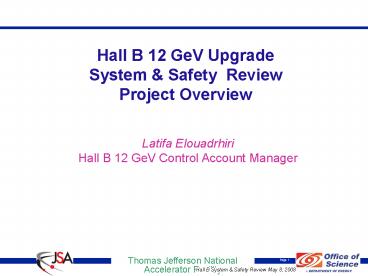Hall B 12 GeV Upgrade System - PowerPoint PPT Presentation
1 / 16
Title:
Hall B 12 GeV Upgrade System
Description:
BST and FST designs can achieve the physics. specifications. robust and proven design ... BST: 4 regions (u-v 'graded stereo' 0o 3o) ... – PowerPoint PPT presentation
Number of Views:38
Avg rating:3.0/5.0
Title: Hall B 12 GeV Upgrade System
1
Hall B 12 GeV Upgrade System Safety
ReviewProject Overview
Latifa Elouadrhiri Hall B 12 GeV Control Account
Manager
2
CLAS12 Design Parameters
The physics program allows to firmly establish
requirements for the CLAS12 performance in terms
of rate capability, particle ID, and
resolution. (See Burkert Talk)
3
Torus and Solenoid Magnets
Reference Design Max. field B5
Tesla Homogeneity ?B/Blt10-4 Main coil 4000
turns Shielding coil 1880 turns Stored energy
25 MJ
Reference Design coils 6 Radial thickness
294mm Width 100mm Stored energy 14MJ
4
Procurement Schedule TORUS
5
Procurement Schedule Solenoid
6
Silicon Vertex tracker
- BST and FST designs can achieve the physics
- specifications
- robust and proven design
- Q coverage BST 35o 125o FST5o 35o
- F coverage 2p
- BST 4 regions (u-v graded stereo 0o 3o)
- FST 3 regions each with u-v stereo strips ( /-
12o ) - Good segmentation, good resolution
- High efficiency for track reconstruction over all
f - Low rate of fake tracks at L1035 cm-2s-1
- Good missing momentum resolution, matched to the
forward detector - Proven by a full event simulation and
reconstruction program
7
DC
8
High Threshold Cerenkov Counter (HTCC)
- Works in conjunction with CLAS Low
ThresholdCerenkov Counter and Preshower
Calorimeter and the CLAS Electromagnetic
Calorimeter, to provide electron identification
in full kinematics - Optical properties defined
- Response to electrons, pions, and background
particles simulated in detail, and meets
requirements for high pion rejection - Operation in magnetic field is used as input for
the design of the solenoid magnet - Sensitivity of PMTs to magnetic field addressed
in RD plan for prototype of multi-layer magnetic
shield. - Light-weight mirror construction techniques
developed to limit impact on 3-momentum
resolution - Light readout segmentation allows use in trigger
decisions
9
Pre-Shower Calorimeters (PCAL)
- Provide sufficient granularity and position
resolution for the separation of photons and p0
for momentaup to 10 GeV/c - Add 5 radiation lengths in depth to EC and
provide full shower and energy containment - Choose design readout that allows use of low-cost
extruded scintillator material and low cost PMTs - Non-projective geometry greatly simplifies
construction and allows significant cost savings - Full GEANT simulation to optimize readout
segmentation
10
Central Time of Flight
- CTOF design with R2083, magnetic shield, and bent
Light Guides will likely achieving the 60 ps
timing resolution. This is based on a realistic
prototype, high statistics tests, and MC
calculations. - Further RD work that is currently underway may
allow lt 60 ps.
- The design allows simple integration of other
PMTs and achieving the desired performance
independently on other systems.
- Extensive documentation of RD work is
publically available in Nucl. Inst. Meth. and
CLAS notes.
- Safety considerations and QA processes have been
defined and are being incorporated in design,
component construction, assembly.
11
Forward Time-of-Flight
12
Design Drawings
DC R2 End Plate Detail
PCAL PMT Header
HTCC Main Assembly
CTOF Fwd light guide support
13
Detector Design and Integration
- Design solutions for all detectors are well
advanced and many are into making detail
fabrication drawings. - Integration of detectors and magnets is being
addressed and magnet specifications being
written. - For systems that mount on the magnets, interface
requirements will be part of specifications for
both components. - Installation and maintenance procedures have been
addressed in detector designs. - Installation plan shows ample float.
- Safety plan is well developed and special issues
including onsite assembly and installation have
been addressed.
14
Online DAQ Electronics
- CLAS12 DAQ will meet requirements 10kHz event
rate, 100MB/s data rate, lt15 dead time - CLAS12 Trigger System will be able to reliably
identify electrons and select multi-particle
events - CLAS12 Electronics exists or currently under
development in JLAB - CLAS12 Online System main components exist and
will be integrated into Experiment Control System
15
Detector Simulation and Event reconstruction
- Full modeling of the CLAS12 Detectors and
magnetic field in place - Detail simulation in the presence of
electromagnetic and hadronic background has been
performed - CLAS12 can operate at the design luminosity
- Track reconstruction code based on Kalman Filter
has been developed for both the forward and
central detectors - Derived resolutions satisfies the physics
requirements - High tracking efficiency at the design luminosity
1035cm-2s-1 - Excellent track matching between Drift Chamber
system and Forward SVT - Forward SVT provides large improvements on track
parameters - 3-10 times better for the vertex, 1.2 -1.9 for f
16
Summary
- CLAS12 technical performance parameters are well
defined - Burkert talk on physics requirements, and the
individual system talks - Construction plans for each system are
well-developed assembly plans consistent with
Upgrade and Hall B installation schedule - Baseline project plan in Cost book and P3e
schedule - Summary presented in Elouadrhiri morning talk,
and Dave kashy for the overall schedule of
installation and integration - Detector likely to achieve performance with low
risk - Overall Low risk based on
- Cost and schedule estimates well-founded and
well-documented - System integration plan within CLAS12 and Hall B
is well studied and developed - Details presented in Kashy talk
- ESH aspects of construction and commissioning
have been incorporated into project plan































